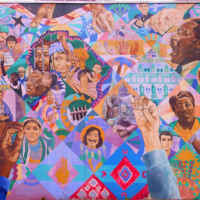
Freedom Quilt Mural
In 1988 David Fichter, with the help of volunteers, painted the Freedom Quilt Mural on the side of the American Friends Service Committee Building in Atlanta, Georgia. The mural was created as part of the Rainbow Coalition events during the 1988 Democratic National Convention. In February 2015 the building, owned by Georgia State University, was torn down – taking the mural with it. The quilted mural is thematically focused on non-violent heroes of history that struggled for justice and peace. It includes the faces of Mubarak Awad, Nelson Mandela, Winnie Mandela, Desmond Tutu, Oscar Romero, Rogoberta Menchu, Leonard Peltier, Andrew Goodman, Fannie Lou Hamer, Daniel Berrigan, Martin Luther King Jr., Rosa Parks, Mahatma Gandhi, and Lucretia Mott. It also includes the antislavery figures of Frederick Douglass and Harriet Tubman. Tubman points towards the North Star. Multi-racial hands stitch the quilt together, joining heroes (both famous and unknown) from all strands of history.
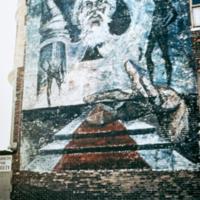
Frederick Douglass
Muralist Al Smith painted the abolitionist Frederick Douglass as a mythic elder statesmen for this Boston mural. Douglass had visited Boston exactly 80 years, from May 28-31, 1888, when he attended the annual convention of the New England Woman Suffrage Association and delivered an address on Women’s Rights at Tremont Temple. “My special mission in the world, if I ever had any,” Douglass told his audience, “was the emancipation of enfranchisement of the negro. Mine was a great cause. Yours is a much greater cause since it comprehends the liberation and elevation of one-half of the whole human family.”
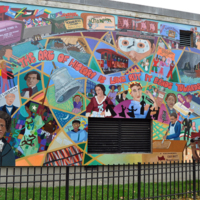
The Arc of History is Long
The muralist David Fichter adapted Martin Luther King Jr.’s famous quotation “the arc of the moral universe is long but it bends towards freedom,” for this 2002 mural in Cambridge, Massachusetts. The mural features Susan B. Anthony, Rosie the Riveter, William Lloyd Garrison and W.E.B. Du Bois, as well as a young Frederick Douglass.At around the same age as he appears in this mural, Douglass gave a speech in nearby Boston on February 8, 1855 where he drew attention to the psychological impact of enslavement: “Whipping is not what constitutes the cruelty of Slavery," explained Douglass. “To me the thought that I am a slave is more terrible than any lash, than any chain.”
![Diego Rivera, Panel V of Portrait of America, New Workers School, New York City, 1933 [destroyed] (2).jpg Diego Rivera, Panel V of Portrait of America, New Workers School, New York City, 1933 [destroyed] (2).jpg](https://486312.frmmmguz.asia/files/square_thumbnails/5a3ba3415ccc36fadeb19c4d16fa1879.jpg)
Portrait of America
In 1933, the Mexican muralist Diego Rivera painted a 21-panel mural titled Portraits of America. Created for New York City’s New Workers School, the mural focused on issues of racial inequality and depicted the antislavery figures Frederick Douglass and John Brown, as well as shackled slaves - seen here in panel five of the mural. Rivera believed art was a weapon in the class struggle and frequently produced murals about revolution. Rivera, David Alfaro Siqueiros and José Clemente Orozco were the pioneers of the Mexican mural movement, and influenced mid-century African American muralists Hale Woodruff, John Biggers and Charles White.
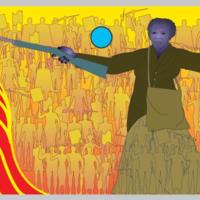
The Dreams of Harriet Tubman
In 2000, muralist Mike Alewitz planned on creating a series of murals about the heroes of the abolitionist movement, titled The Dreams of Harriet Tubman. Alewitz’s goal was to have the Dreams series as a necklace of murals across the state of Maryland with the flagship mural on a major wall in the city of Baltimore. This mural would depict Harriet Tubman, who was also known as Moses. In a pre-circulated plan on Black Radical Congress General News, Alewitz described how the flagship mural would have an army of freedom fighters (Martin Luther King Jr., Malcolm X, Mumia Abu Jamal, Sojourner Truth and Robert Gould) standing behind a musket-wielding Tubman. But the mural stirred up controversy when the group who had planned to display the mural, the Associated Black Charities Inc., decided the piece could be construed as racist and violent. Alewitz was asked to replace the musket but he refused: “I will not disarm Harriet Tubman. I won’t take [the musket] out of her hands.” The lack of a major wall was a setback for the Dreams series and another of the murals, on a wall in Hartford County, was defaced in the summer of 2000 by racist graffiti.
![Anonymous, W Florence & S Western Aves, South-Central LA (Black Neighborhood), 1999 [destroyed].jpg Anonymous, W Florence & S Western Aves, South-Central LA (Black Neighborhood), 1999 [destroyed].jpg](https://486312.frmmmguz.asia/files/square_thumbnails/7fabdee3546a6cb70ee280e97b7dd315.jpg)
Martin Luther King Jr., Malcolm X and Frederick Douglass
This mural of Martin Luther King Jr., Malcolm X and the abolitionist Frederick Douglass appeared in south-central LA in 1999 and had been destoyed by 2010.
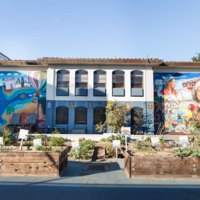
Now and Then
In 1996, the Rafael Elementary School in San Francisco changed its name to Rosa Parks Elementary School, and the San Francisco School Board president commissioned a mural to mark the new name. The mural was a community effort by students from the Art Institute, the Academy of Art and San Francisco State University. It aimed to make children aware of Rosa Parks. Once the mural was finished, Parks herself came to unveil it. Also included on the wall are the antislavery figures Harriet Tubman and Frederick Douglass, as well as Thurgood Marshal and W.E.B. Du Bois.
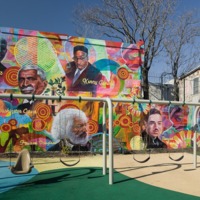
The Faces That Shape Us
On May 25, 2011, a mural titled The Faces That Shape Us, was dedicated in Uncle David’s Playground. Mr Kenneth Gamble (pictured on the mural), the founder and chairman of Universal Companies, had bought a rundown building in South Philadelphia and tore it down. He wanted to bring something positive to the neighbourhood and so he funded a local children’s playground, complete with a mural. Muralists Keir Johnston and Ernel Martinez started the mural in the summer of 2010. The mural features Frederick Douglass and other historical figures such as W.E.B. Du Bois, George Washington Carver and James Baldwin, as well as local figures Dr. Emmett Chapell, Judge Frederica Jackson, and Faatimah Gamble. The mural was developed through a partnership with Universal Companies, the Philadelphia Prison System and the City of Philadelphia Department of Human Services.
![Curtis Lewis, African Amalgamation of Ubiquity, 9980 Gratiot Avenue, Detroit, Michigan, 1985 [destroyed in 2013].jpg Curtis Lewis, African Amalgamation of Ubiquity, 9980 Gratiot Avenue, Detroit, Michigan, 1985 [destroyed in 2013].jpg](https://486312.frmmmguz.asia/files/square_thumbnails/3ac63b31ad894031e7c74b99651ace4a.jpg)
African Amalgamation of Ubiquity
In 1985, muralist Curtis Lewis created a mural on the side of a drug rehabilitation centre on Gratiot Avenue, Detroit, Michigan. The building belonged to Operation Get Down and included the antislavery figures Frederick Douglass and Harriet Tubman, as well as Malcolm X, Mary McLeod Bethune, Jesse Jackson, Thurgood Marshall, Martin Luther King Jr., W.E.B. Du Bois, Booker T. Washington, Ida B. Wells, Marcus Garvey and Nelson Mandela, alongisde Egyptian, Nubian and pharaoh figures. The man who breaks free of his chains in the centre of the mural holds a sign that reads, “Behold my people, arise, stand strong and proud, for ye come from pharaohs, emperors, kings and queens.” The mural was destroyed in 2013.
![John Weber, All Power to the People, Cabrini-Green Public Housing Development, 357 W. Locust St, Chicago, 1969 [destroyed].jpg John Weber, All Power to the People, Cabrini-Green Public Housing Development, 357 W. Locust St, Chicago, 1969 [destroyed].jpg](https://486312.frmmmguz.asia/files/square_thumbnails/5bee9c55de2e128c0239ac4a0793b9c0.jpg)
All Power to the People
In 1969, in the courtyard of Saint Dominic’s Church in Cabrini-Green, John Pitman Weber painted All Power to the People with a team of black teenagers. The 37-foot-long mural put the antislavery leader Frederick Douglass alongside Malcolm X, Huey P. Newton and Erika Huggins on the right-hand-side. On the left are skeletons of police officers and a statement by the leader of the Chicago Black Panther Party, Fred Hampton: "Dare to Struggle, Dare to Win." A raised Black Power fist, enveloped by flames, holds broken chains in a symbol of self-emancipation. A few months after the creation of this mural, Fred Hampton was shot and killed by the FBI under J. Edgar Hoover’s COINTELPRO. Weber was a white Harvard graduate and Fulbright scholar. The mural was one of the first collaborations between untrained community residents and a trained artist, a method that became common practise for American community murals.
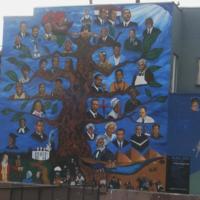
Black Seeds
In 1991, a group of artists – Eddie Orr, David Mosley, William T. Stubbs, Norman Maxwell and Michael McKenzie – collaborated to paint “Black Seeds” on an empty wall in Leslie N. Shaw Park on Jefferson and 3rd Avenue in Los Angeles. The idea for the mural, which appears as an African American tree of life, came from Vietnam veteran and local activist Gus Harris Jr. He recalled how little he learned about African American history in school. He wanted to create a public mural about black individuals who made an important contribution to society.The mural was created under the Social and Public Art Resource Center's 1990-91 “Neigborhood Pride: Great Walls Unlimited” mural program and features the antislavery leaders Harriet Tubman and Frederick Douglass, as well as Booker T. Washington, Thurgood Marshall, Mary McLeod Bethune, Malcolm X, George Washington Carver, Paul Robeson, Stevie Wonder, Shirley Chisholm, Martin Luther King Jr., and Jesse Jackson. The mural was restored by Moses X. Ball to include Barack Obama after 2008. The original canvas upon which the mural was based hangs in Oaks Jr. Market Corner Store at 5th and Jefferson.
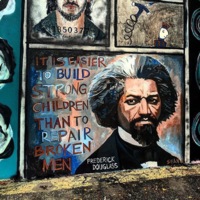
Strong Children
Painted by Charleston-based artist Sean Williams, this mural depicts the antislavery leader Frederick Douglass in the younger phase of his life, and uses his statement from in 1855, “It is easier to build strong children than to repair broken men.” The mural is in a church parking lot in Charleston, South Carolina.
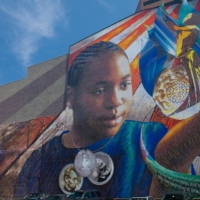
Lincoln Legacy
This large mural by Joshua Sarantitis, Lincoln Legacy, can be read from left to right, moving from Africa to America. The shape of Africa adorns the backdrop until the wooden boards of the slave ship transform into the American flag. Around the young child’s neck are three medallions: Abraham Lincoln’s face, Josiah Wedgwood’s abolitionist icon “Am I Not a Man and a Brother,” and Frederick Douglass' face. Made up of over 1 million glass mosaic tiles, it is the largest Venetian glass tile mural in Philadelphia at over 10,000 square feet. Located a block away from the Liberty Bell and Independence Mall, it is one of the few murals to be created in Philadelphia’s wealthier districts.
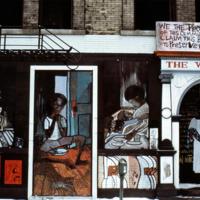
Wall of Truth
Although sharing an address with the famous Wall of Respect, the Wall of Truth was different. Whilst the Wall of Respect exalted black role models, leaders and liberators, the Wall of Truth wove negative scenes of poverty, brutality and racism into the fabric of the urban environment. Rather than promoting racial pride, it highlighted racial disparities. “The intent on the opposite side [of the road] was that things had gone more militant,” muralist Eugene Wade explained: “more blackness was needed in terms of representing the Black Power symbol and the whole thrust of what was happening in the black community.” Wade notes that “people were getting angry and fed up, so what we were trying to do was implement the attitude and the mood."The Wall of Truth was a significantly larger mural than its Chicago neighbour, the Wall of Respect. It spanned the length of an apartment building, and wrapped around onto an adjoining wall. It contained nine separate narrative panels and was one of the first instances that a radical black past was visualised in the streets through the antislavery leaders Frederick Douglass and Nathaniel Turner, as well as Mary McLeod Bethune, W.E.B. Du Bois, H. Rap Brown, Stokely Carmichael, Marcus Garvey, Huey P. Newton, Fred Hampton, and Malcolm X.
![Parkview Recreation Center Mural, Northwest at Otis Pl (Black Neighborhood), Washington DC, 1990s [destroyed 2010].jpg Parkview Recreation Center Mural, Northwest at Otis Pl (Black Neighborhood), Washington DC, 1990s [destroyed 2010].jpg](https://486312.frmmmguz.asia/files/square_thumbnails/2f5b42d937293f1b46430d226884e60b.jpg)
Parkview Recreation Center Mural
This mural was painted in the 1990s on the side of the Parkview Recreation Center in northwest Washington D.C. It depicts the faces of Thurgood Marshall, Mary McCleoud Bethune and the antislavery leader Frederick Douglass. In 2010 the mural was repainted and includes the same faces.
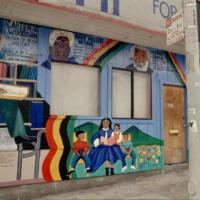
Scenes from the Bayview Opera House
Painted in 1995 in San Francisco by artist Leboriae P. Smoore, this mural acts as a children’s textbook in the street, teaching about the antislavery leaders Harriet Tubman and Frederick Douglass, and other black figures: Carter G. Woodson, Mary McLeod Bethune, W.E.B. Du Bois, Ida B. Wells, and Jackie Robinson.
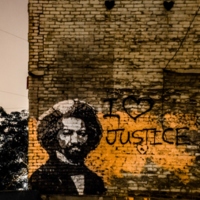
Frederick Douglass
The artist St George completed this stencil of a young Frederick Douglass in 2013. It had been destroyed by 2017.
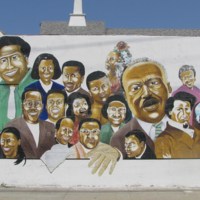
Wings of Faith
In 2005, an anonymous artist painted a mural in Los Angeles that depicted many heroes of African American history. The faces of antislavery leaders Sojourner Truth and Frederick Douglass, alongside Muhammad Ali, Martin Luther King Jr., Malcolm X and Rosa Parks, lined the street. By 2015, the building had fallen into disrepair and the mural had been destroyed.
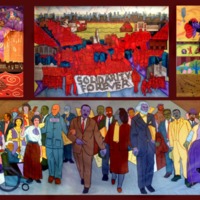
The City at the Crossroads of History
In 2011, the Puffin Foundation commissioned Mike Alewitz to paint a mural for the Puffin Gallery of Social Activism that would be on display in the Museum of the City of New York. Completed in 2014, the mural is a tribute to the labour and social justice movements and contains four panels. It includes slave ships and depicts the antislavery leader Frederick Douglass, as well as Martin Luther King Jr., Coretta Scott King and Elizabeth Gurley Flynn.However after viewing the mural, the museum declined to display it. They requested changes that reduced the prominence of Martin Luther King Jr. and added the Women’s Christian Temperance Union. Alewitz calls this a case of censorship and continues to campaign for his mural to be displayed.
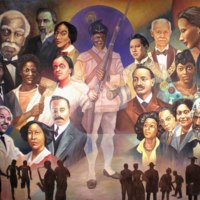
The Shoulders of Heroes We Lean On
This mural was created in 2012 by Munir D. Mohammad for the Rhode Island Black Heritage Society, one of the oldest African heritage organisations in the country. Titled The Shoulders of Heroes We Lean On, the mural depicts giants of black history, including the antislavery leader Frederick Douglass, as well as the silhouettes of athletes, musicians and scholars.